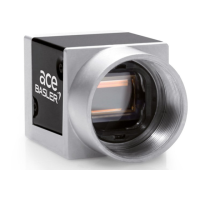Basic Operation & Standard Features
3-10 BASLER A102
f
DRAFT
The ExTrig signal must be used in combination with a one-shot or a continuous-shot command. If
more precise control of exposure start time is desired, you must also monitor the Trigger Ready
signal and you must base the timing of the ExTrig signal on the state of the Trigger Ready signal.
(See Section 3.2.6 for recommended methods for using the signal)
The following descriptions assume that the ExTrig signal is set for rising edge triggering and the
programmable exposure mode.
ExTrig / One-Shot Operation
In ExTrig/One-shot operation, a “One-shot” Command is used to prepare the camera to capture
a single image. When the ExTrig signal rises, exposure will begin. To use this operating method,
follow this sequence:
1. Use the shutter settings described in Section 3.2.1 to set your desired exposure time.
2. Set the One Shot field of the One Shot/Multi Shot control register to 1.
3. Check the state of the TrigRdy signal:
a) If TrigRdy is high, you can toggle ExTrig when desired.
b) If TrigRdy is low, wait until TrigRdy goes high and then toggle ExTrig when desired. (See
Section 3.3 for more about TrigRdy.)
4. When ExTrig rises, exposure will begin. Exposure will continue for the length of time you
specified in step 1.
5. At the end of the specified exposure time, readout and transmission of the captured image
will take place.
The One Shot field of the One Shot/Multi Shot control register is self cleared after image
transmission.
ExTrig / Continuous-Shot Operation
In ExTrig/Continuous-shot operation, a “Continuous-shot” command is used to prepare the
camera to capture multiple images. With this method of operation, exposure will begin on each
rising edge of the ExTrig signal. To use this operating method, follow this sequence:
1. Use the shutter settings described in Section 3.2.1 to set your desired exposure time.
2. Set the Continuous Shot field of the ISO En/Continuous Shot control register to 1 (see page
4-17)
3. Check the state of the TrigRdy signal:
a) If TrigRdy is high, you can toggle ExTrig when desired.
b) If TrigRdy is low, wait until TrigRdy goes high and then toggle ExTrig when desired. (See
Section 3.3 for more about TrigRdy.)
4. When ExTrig rises, exposure will begin. Exposure will continue for the length of time you
specified in step 1.
5. At the end of the specified exposure time, readout and transmission of the captured image
will take place.
6. Repeat steps 3 and 4 each time you want to begin exposure and capture an image.
7. To disable continuous-shot operation, set the Continuous Shot field in the ISO En/
Continuous Shot control register to 0.

